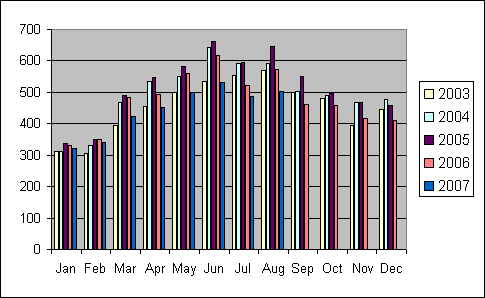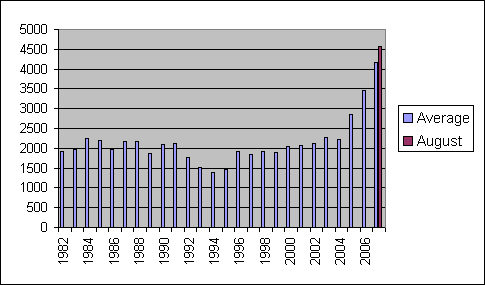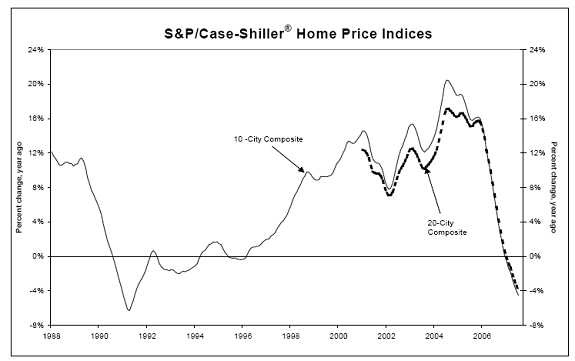New data released today portend continued weakness for housing.
The National Association of Realtors today reported numbers for August existing home sales. The seasonally unadjusted number of single-family existing homes sold was up 3.1% over July. However, some pickup in home sales at the end of summer is to be expected, and seasonally adjusted that August datum gets reported as a 3.8% drop. The seasonally unadjusted figure is down 12% from August 2006 and down 22% from August 2005.
 |
Remember that unlike the new home sales numbers that will come out on Thursday, the existing home sales are based on date of escrow, so that most of the contracts for these sales were likely signed in July or June, before the big problems with international capital markets began August 9. It’s hard to see how those recent developments won’t contribute to further deteriorating conditions for home sales. Mark Thoma calls our attention to these observations from Federal Reserve Bank of San Francisco economist Eric Swanson:
Delinquency and default problems on subprime mortgages appear to have led to a loss of confidence in the underwriting and rating standards on subprime and other nonconforming (such as “no-doc” and “jumbo”) mortgage loans. As a result, the secondary market for these loans has largely evaporated. Since these loans cannot be securitized at present, lenders have either stopped making nonconforming mortgage loans altogether or have tightened standards for them considerably, even for prime borrowers, because those loans must be held on the lender’s own books until demand for nonconforming mortgage-backed securities revives.
One of the reasons this account troubles me is that it seems to portray a capital market without a compass, in which no one has the tools to evaluate which loans are sound and which are not. That fact in itself makes me concerned about exactly what we’ve gotten ourselves into with the prospects of defaults on existing mortgages.
In any case, it’s hard to see how curtailment of jumbo loans wouldn’t have a big impact on those real estate markets like San Diego where huge loans are often needed to purchase many of the homes for sale. I also observe that even though the August existing home sales were up on a seasonally unadjusted basis, that wasn’t enough to keep the inventory of unsold homes from rising another half percent from July, which puts it up 19% from August 2006 and up 60% from the average level of 2005.
 |
And that means more pressure on house prices. The widely-reported median sales price also released by the NAR is not a particularly meaningful number, since the homes sold in August could have very different locations and characteristics from those sold in July. Much better is the Case-Shiller home price index, which tries to follow the price of a particular home in a given community and combine those into an aggregate index. Their index shows a 3.9% decline in home prices nationally and 7.8% decline here in San Diego over the last year.
 |
Surely it’s hard to dismiss the possibility of significant further declines in real estate prices. And what exactly will that mean for the financial repercussions of interlocking and leveraged holdings of mortgage-backed securities?
That’s what has me worried.
Technorati Tags: macroeconomics,
housing,
mortgage backed securities,
house prices,
Federal Reserve,
San Diego,
economics
Thanks JDH for this thoughtful overview. Just a small thing: the Shiller graph above giving us a better picture of the house price declines –does it account for the increased portion of megahouses (sure, comparing mega houses with megahouses) in the overall indices?
Sorta like the worry about the Gini coeff not really capturing the very top end.
Last thing: I worry about that portion of home owners who thought they were becoming home owners (for years in some cases) and now face the disappointing possibly incendiary reality: unless house prices drop, (ok, or wages rise) they will be helping landlords and not their American Dream.
Calmo, roughly speaking, a $1 million house would influence the index as much as two $500,000 houses. Details are here.
September 25, 2007
Today’s word is confidence. Sadly, it’s only a word:
Consumer confidence slumped to the lowest level in almost two years and home sales weakened, threatening U.S. household spending and bolstering the case for the Federal Reserve to keep cu…
Check out this truly amazing graph of home foreclosures per month in San Diego County. Set the start year to 1982 to get a historical perspective.
http://www.sddt.com/Finance/EconomicIndicators.cfm
Two items.
First, Coldwell Banker has a yearly product which only considers sequential resales of 2200 sqft (2100-2300) 4/2.5/2s on approx 10,000 sqft lots which are suitable for occupancy by “executives” due to location and condition. It is available in their HPCI database for several cities in each state. Though it has a very, very narrow construction this product gives a reasonably accurate look at how the year/year price of such a residence has changed.
Second, when the Congress returns in 2008 I have no doubt that waves of legislation will be enacted in an attempt to prevent prices from falling to a market clearing level. Just how far THAT insanity will progress I hesitate to speculate but do believe that it will be unlike anything witnessed since the 1930s.
Hold on to your wallets.
Here is the best view of the future currently available (though still lightly traded)…
The Chicago Board of Trade extended it’s futures market on the Case-Shiller 10 City Index from 1 year to 4 years last weekend …with very little fanfare, since this is the ONLY place I saw it posted:
http://www.housingwire.com/2007/09/19/back-to-the-futures-investors-see-four-years-worth-of-housing-slump/
The 10 city index looks to be at about -24% in four years. The scary part is that at 4 years …it’s still dropping!
Hmmmm …spoke too soon! Actually Bespoke picked it up today:
http://bespokeinvest.typepad.com/bespoke/not-for-the-meek-at-heart.html
It appears that a couple more days of trading have actually predicted shorter and shallower declines (some cities turn back up in 2-3 years).
I actually consider this very bullish though, since the index adjusts for inflation. This would mean many cities will stay WAY above their historic trend line (and fundamentals).
Mark Thoma is exactly correct but since the secondary market is a source of income and a major part of the loan business, shouldn’t this business return when the supply works down?
Also, if intest rates decline so that new loans are lower than interest rates on existing loans wouldn’t that make the secondary market more attractive and stimulate an increase in activity?
It seems that now that the FED is lowering interest rates that we simply need to wait this one out. The correction will come unless the FED takes us back toward recession by fighting non-existent inflation.
DickF – I admire your optimism, but the housing bubble is not returning in our lifetime. Loans were given to people with no jobs and low credit scores …then resold as low risk investments to banks and pension funds around the world. It’s called fraud. People should go to jail.
Subprime, flippers, no money down, and Jumbo loans (over $417k) are no longer part of demand because their rates are much higher (regardless of what the Fed does). And the latest Fed cut actually increased 30 year bonds due to inflation worries (which RAISED mortgage rates!).
Anyway, it’s not even about the rates anymore. An expensive house still generates expensive payments even if the rates are low. It’s even more expensive if it’s dropping in value. The fundamentals are out of wack compared to renting and salaries …and most importantly the psychology has shifted.
The expansion over the last 5 years, built mostly on debt, is over. RIP
Professor, it’s time to sell that fancy La Jolla place of yours and hoard your otherwise ephemeral gains!
NoFate, in my view, has this right. Sadly, esb’s second point seems to guaranteed, as well.
I’m really surprised that there’s still any question about which way the Real relative value of residential Real Estate is heading.
This, from JDH: “And what exactly will that mean for the financial repercussions of interlocking and leveraged holdings of mortgage-backed securities?”
Is The Question of the Age. I think what we saw this Summer ‘007 was akin to (mixing metaphors) coming back from Vacation and seeing the Financial System’s EKG Flatlining.
NoFate,
I am not a bubble man. The value of houses were what they should have been for the market that was active at the time. It was primarily a capitalization of the low interest rate.
I know a lot of loan officers who wrote loans as you have described and they were totally legal. If you are going to send people to jail you will need to change the law.
I am not looking for a return to the appreciation we were seeing a few years ago. I am just looking for us to have a secondary market once again. Right now no one is buying and that is a plug in the pipeline. I have a friend at Citi who told me she is preparing twice as many loan packages as a couple of years ago but Citi is only accepting about as many as they did before.
It is like inventory. The FED created the inventory with low rates then created the backlog by raising rates, changing the rules in the middle of the game. The FED pulls this about every 5 years of so and they always catch people.
touche, taking a look at that San Diego foreclosures graph, I see that the historical average until 2001 was much higher than during the 2000s. For a stretch from 1992-7, the average was more than 400 foreclosures a month. However, from 2001-6, the rate dropped to less than 100 foreclosures a month, presumably because of a combination of the credit glut and bad lending decisions. Perhaps the current spike to upwards of 800 foreclosures a month is merely a delayed reaction to that artificial lowering, in order to bring it back to the historical average? If so, perhaps we should just let the market sort things out and not panic. 🙂